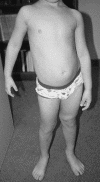A case of familial isolated hemihyperplasia
- PMID: 15040809
- PMCID: PMC373451
- DOI: 10.1186/1471-2350-5-1
A case of familial isolated hemihyperplasia
Abstract
Background: Hemihyperplasia (hemihypertrophy) is defined as asymmetric body overgrowth of one or more body parts. Hemihyperplasia can be isolated or be part of well-defined syndromes such as in the case of Beckwith-Wiedemann syndrome (BWS). Isolated hemihyperplasia is usually sporadic, but a number of familial occurrences have been described.
Case presentation: We describe a Tunisian family in which three maternal cousins and their maternal grandfather present with isolated hemihyperplasia.
Conclusions: The etiology of isolated hemihyperplasia is unknown although in BWS, genomic imprinting has been shown to play a role in the asymmetric overgrowth. Given the similarity between these two conditions, it is possible that both may share a common pathogenesis. We also discuss the possible genetic mechanisms leading to the production of hemihyperplasia in this family.
Figures
Similar articles
-
Hemihyperplasia-multiple lipomatosis syndrome: an underdiagnosed entity in children with asymmetric overgrowth.J Pediatr Surg. 2010 Jan;45(1):E19-23. doi: 10.1016/j.jpedsurg.2009.10.059. J Pediatr Surg. 2010. PMID: 20105568
-
Isolated facial hemihyperplasia: manifestation of Beckwith-Wiedemann syndrome.J Craniofac Surg. 2008 Jan;19(1):279-83. doi: 10.1097/SCS.0b013e31815ca067. J Craniofac Surg. 2008. PMID: 18216702
-
Isolated hemihyperplasia (hemihypertrophy): report of a prospective multicenter study of the incidence of neoplasia and review.Am J Med Genet. 1998 Oct 2;79(4):274-8. Am J Med Genet. 1998. PMID: 9781907 Review.
-
Diagnostic criteria and tumor screening for individuals with isolated hemihyperplasia.Genet Med. 2009 Mar;11(3):220-2. doi: 10.1097/GIM.0b013e31819436cf. Genet Med. 2009. PMID: 19367194 Free PMC article.
-
Silver-Russell and Beckwith-Wiedemann syndromes: opposite (epi)mutations in 11p15 result in opposite clinical pictures.Horm Res. 2009 Apr;71 Suppl 2:30-5. doi: 10.1159/000192433. Epub 2009 Apr 29. Horm Res. 2009. PMID: 19407494 Review.
Cited by
-
Medullary sponge kidney and isolated hemihyperplasia.Indian J Nephrol. 2014 Jul;24(4):243-5. doi: 10.4103/0971-4065.133013. Indian J Nephrol. 2014. PMID: 25097338 Free PMC article.
References
-
- Bueno I, Ventura P, Samper MP, Perez Gonzalez JM, Bueno M. Congenital hemihypertrophy. Genet Couns. 1993;4:231–4. - PubMed
-
- Ballock RT, Wiesner GL, Myers MT, Thompson GH. Hemihypertrophy. Concepts and controversies. J Bone Joint Surg Am. 1997;79:1731–8. - PubMed
-
- Hoyme HE, Seaver LH, Jones KL, Procopio F, Crooks W, Feingold M. Isolated hemihyperplasia (hemihypertrophy): report of a prospective multicenter study of the incidence of neoplasia and review. Am J Med Genet. 1998;79:274–8. doi: 10.1002/(SICI)1096-8628(19981002)79:4<274::AID-AJMG8>3.3.CO;2-K. - DOI - PubMed
-
- Leck I, Record RG, McKeown T, Edwards JH. The incidence of malformations in Birmingham, England, 1950–1959. Teratology. 1968;1:263–80. - PubMed
-
- Parker DASkalko RG. Congenital asymmetry: report of 10 cases with associated developmental abnormalities. Pediatrics. 1969;44:584–9. - PubMed
Publication types
MeSH terms
LinkOut - more resources
Full Text Sources
Medical



